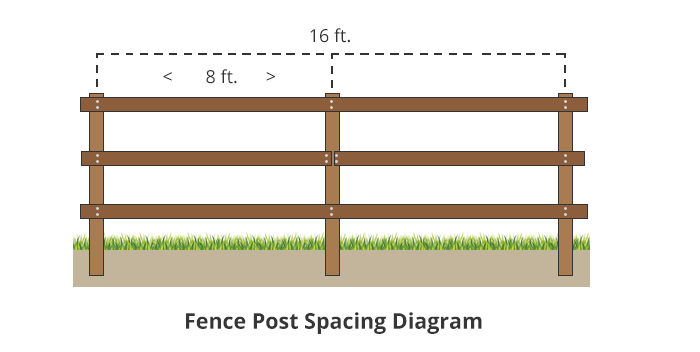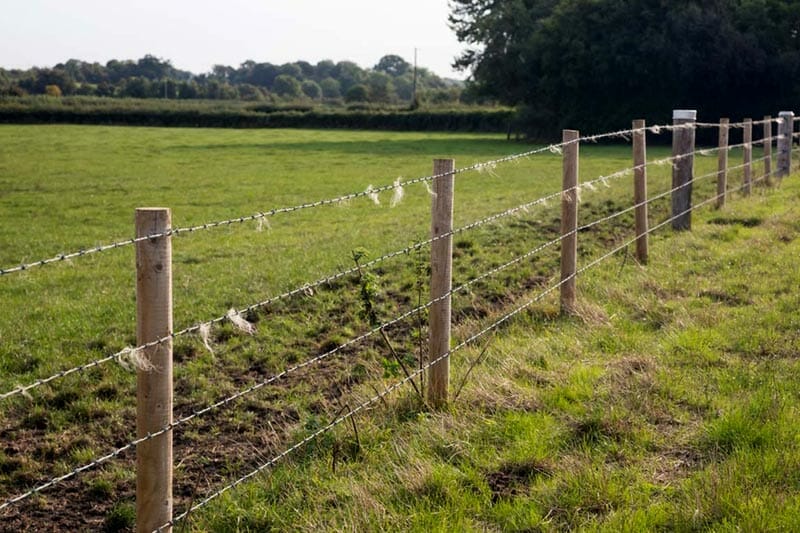What is the number of posts required to fully encircle an acre of land with a fence?
The number of posts required to fence an acre of land depends on the spacing of the posts. To find the number of posts you need for an acre, you divide the fence length by the spacing and add one post.
On average, fencing posts have 8 – 12 feet of spacing. Therefore, you will have 76 – 110 posts to fence an acre.
Let us look further into fencing an acre of a farm field.

Fence post spacing chart
| Post spacing | # posts per acre | |
|---|---|---|
| Post and wire fencing | 8 - 12 feet | 76 - 110 posts |
| Cattle fence | 8 feet | 76 - 80 posts |
| Hog wire fence | 8 feet | 76 - 80 posts |
| Steel fence | 15 - 20 feet | 45 - 60 posts |
| Wood fence | 8 feet | 110 posts |
| 4 strand barbed wire fence | 20 - 30 feet | 30 - 45 posts |
| Chain link fence | 10 feet | 90 posts |
| High-tensile | 20 - 30 feet | 32 - 48 posts |
| PVC | 8 feet | 110 posts |
| Split rail | 8 feet | 110 posts |
Number of fence posts for a 1/2 acre lot
A 1/2 acre lot of land is 21,780 square feet with a circumference of 417 linear feet. Most fences use an 8 foot section of fence, so you will need to calculate the number of fence posts based on that.
417 divided by 8 = 52
You will need 52 x 8 foot sections of fence for a 1/2 acre lot which needs 52 fence posts in total
Number of fence posts for a 1/4 acre lot
A 1/4 acre plot of land is 10,890 which is the average land size right across America. A 1/4 acre lot has 208 linear feet around the perimeter.
208 divided by 8 = 26
You will need 26 x 8 foot sections of fence for a 1/2 acre lot with a total of 26 fence posts being required.
What is the max distance I can have between fence posts?
The distance between fence posts depends on the type of fence you want and the material of the posts.
For high-tensile fence materials and fences with metal posts, the maximum spacing falls to about 20-30 feet. For fence materials that are not too strong, the maximum spacing is 8-12 feet.
Post spacing determines the strength of your fence.
Factors To Consider When Buying Fencing Posts
Material
Fencing posts are available in a range of materials. You could buy plastic, concrete, or wooden fencing posts.
To fence an acre of land, you need affordable posts. High-cost posts will raise the cost of fence installation astronomically.
Therefore, wooden or plastic posts are the best. Ensure that the wooden posts are chemically treated before purchase.
Plastic posts are pest resistant, durable, and will not break or harm animals that scrape against them. They are also affordable and easy to use.
Height
You can get fencing posts in any height from 4 to 8 feet. The height of the fencing posts depends on the height of the fence. The longer the fencing posts, the more you pay for them.
Most farmland fences range between 4 and 6 feet tall. It can keep animals from straying or jumping over the fence. Privacy fences, mostly used for homes may be as high as 8 feet.
Decide on the height of the fence you need before you purchase the fencing posts.

Cost Factors To Consider When Fencing Farm Field
Fencing material
The fence material you choose to use determines how much land fencing will cost.
Further, the fencing material you choose depends on the type of land you are fencing and its use.
Farmland fencing costs $1 to $60 per foot
Here is a comparison of prices for the different types of fencing materials.
| Fence Material | Cost per foot |
|---|---|
| Wire | $1 - $6 |
| Chain link | $12 - $30 |
| Wood | $15 - $30 |
| Vinyl | $18 - $39 |
| Composite fence | $25 - $57 |
| Aluminum | $28 - $55 |
| Wrought iron fence | $28 - $55 |
Size of the land
The size of the land to fence implies how much money you will spend. The larger the plot, the more you will pay.
The amount of materials you need depends on the size of the land. The more materials you need, the more you will spend on fencing.
Further, the larger the land, the more you pay for labor.
Pipe fencing is suitable for any size of land. You can use it in small plots or large farms.
Land topography
How the land looks also determines how much you spend on fencing.
It costs more to fence a sloping land than flat land.
Since sloping land is harder to work on, it will cost you more to fence it.
When working on flat land, the work will move fast and will not require advanced tools or carrying heavy loads over large distances.
Usually, sloping land needs grading to make it easy to work. The cost of grading increases the cost of fencing.
Labor cost
You can DIY or hire a pro to help install a fence on your land. You will save on labor costs if you DIY. However, fencing land is a job best left to professionals.
The larger your land, the more you will pay for fencing. The slopier your land, the more difficult it is to work on, and the more you will pay.
Labor cost is additional to the material cost. Hence, increasing the fencing cost. Labor costs depend on the location of your land, the expertise of those you hire, and more.
Fence height
The higher the fence, the more it costs.
The higher the fence, the more materials it needs. Thus, the higher the cost. It will also take longer to install, increasing the labor costs.
Obstacles on the land
The more obstacles on the land, the higher the fencing cost. Trees are some of the fencing obstacles.
If there are trees on the fencing path, you have to remove them or go around them. Tree removal is expensive and is an additional cost when fencing your land.
If you have to go around the trees, you increase the distance for fence laying. As a result, you will need more posts which increases the cost of fencing.
Factors To Consider When Choosing Farm Field Fence

Fence Material
There are many types of fence materials that you can buy. The purpose of your fence determines the material you will use.
For agricultural land, you can use barbed wire, mesh wire, wood, or electric wire as your fence material.
Some materials require more maintenance than others. A wood fence requires chemical treatment and regular painting, When you install it, ensure that there is proper drainage or that it does not come into contact with water. Regular maintenance eliminates pests that cause it to rot and replace.
Concrete fences require little maintenance and last for a lifetime.
Animals
If you keep animals on your land, make sure to pick the right fence material.
First, ensure that the fence you pick is strong and flexible enough to withstand a hit from the animals.
Your flocks are likely to weaken the fence as they search for more pasture. Choose a sturdy fence material that will not give in to hits and pushes from the animals.
Additionally, ensure that the fence material you choose does not injure your flock if they bump against it.
Is It Cheaper To DIY Or Hire A Pro To Install A Fence
Depending on the type of fence you want to install, DIY is always the cheaper option.
You can opt for DIY to save on costs. However, if you do not have the skills to install a fence, it is better to hire a pro.
You are likely to make errors at installation. Errors may cause you to hire a pro to repair.
While it may be expensive to hire a pro, your fence is installed faster and correctly. You may not have to suffer a loss if there is an installation error.
How To Save Money on Your Fencing Project
- Choose affordable fencing materials.
- Make accurate estimates on the size of the land to purchase the right amount of fence materials.
- Choose a moderate style on your fence. The more elegant the fence, the more expensive it is.
- DIY fence installation.
- Hire affordable professionals to install your fence.
- Carry out some tasks by yourself to save on the amount of money you pay to professional installers.
- Get at least three quotes from professional fence installers to hire one within your budget.
Hire A Pro To Install Your Fence
Homegardenguides.com is a free tool to hire professional fence installation service providers.
It connects homeowners to professionals in the following easy steps.
- Enter your zip code at the top of the tool.
- Fill in the form to provide more details about the fence installation service you need.
- You will receive three or four quotes and advice from professional fence installers.
- Contact and hire a service provider that falls within your budget.








